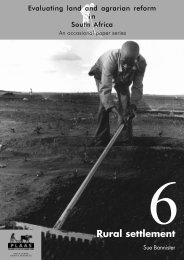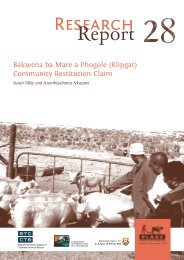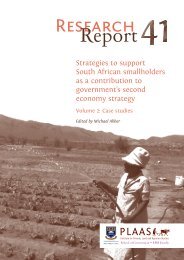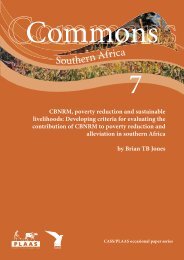A critical appraisal of South Africa's market-based land reform policy
A critical appraisal of South Africa's market-based land reform policy
A critical appraisal of South Africa's market-based land reform policy
Create successful ePaper yourself
Turn your PDF publications into a flip-book with our unique Google optimized e-Paper software.
A <strong>critical</strong> <strong>appraisal</strong> <strong>of</strong> <strong>South</strong> Africa’s<br />
<strong>market</strong>-<strong>based</strong> <strong>land</strong> <strong>reform</strong> <strong>policy</strong><br />
and later told they were successful and<br />
could lease the farms.<br />
The LRAD programme was initiated in<br />
2001 by the DoA, which sent <strong>of</strong>ficials to<br />
explain the LRAD programme to the<br />
farmers who were leasing the <strong>land</strong>. The<br />
beneficiaries were told that the government<br />
wanted to get rid <strong>of</strong> all the farms they<br />
owned and were therefore <strong>of</strong>fering them<br />
for sale to the leaseholders (interview 14).<br />
They were encouraged to apply for LRAD<br />
grants and assisted with filling in the<br />
required forms. It was explained that the<br />
grant would reduce the amount <strong>of</strong> money<br />
they would need to borrow to buy the<br />
<strong>land</strong>, and that they would receive the <strong>land</strong><br />
at less than the <strong>market</strong> price.<br />
While the beneficiary perceptions <strong>of</strong> the<br />
process are positive, there is some confusion<br />
about the time frames for project<br />
application and approval. DLA lists all the<br />
projects on the Steilloop farms as having<br />
been approved on 12 November 2001,<br />
except that <strong>of</strong> Mr Lehong on Vergenoeg<br />
that was approved on 2 August 2002.<br />
However the beneficiaries report having<br />
been formally told <strong>of</strong> the approval only in<br />
September 2002 according to Mr Kgatla<br />
(interview 15) and even January 2003<br />
according to Mrs Morapedi (interview 17).<br />
At the time <strong>of</strong> the interviews in March<br />
2003 they were still waiting for the title<br />
deeds, a factor hampering their ability to<br />
obtain further loans. Some are not even<br />
sure <strong>of</strong> the exact size <strong>of</strong> the <strong>land</strong> they now<br />
own (interviews 13 and 14). Despite these<br />
uncertainties, they noted that from the time<br />
<strong>of</strong> filling in the forms they were given<br />
strong assurances by the <strong>of</strong>ficials that their<br />
applications would be accepted. According<br />
to DLA the problems <strong>of</strong> establishing the<br />
correct <strong>land</strong> size stem from the use <strong>of</strong> old<br />
data that turned out to be inaccurate. They<br />
have since appointed surveyors to clarify<br />
the exact boundaries and farm sizes, and<br />
will update this information on their<br />
records <strong>of</strong> approved projects (interview 33).<br />
The farms acquired range in size from<br />
1 470ha–1 710ha and all are being used<br />
for cattle farming. All beneficiaries got the<br />
maximum R100 000 grant and also<br />
received substantial loans in the range<br />
R219 000–R333 400 from the Land Bank.<br />
The loans were organised by DLA as part<br />
<strong>of</strong> the LRAD process, and the full loan and<br />
grant amounts were used for the purchase<br />
<strong>of</strong> the <strong>land</strong>. As in Manamead a production<br />
valuation rather than <strong>market</strong> valuation was<br />
done by the Land Bank and all the farms<br />
were obtained at a very reasonable price<br />
(an average <strong>of</strong> R232.94 per hectare). As<br />
one <strong>of</strong> the beneficiaries said, ‘I can say it<br />
was for free, because it was not very<br />
expensive’ (interview 17).<br />
There are five beneficiaries, four men<br />
and one woman, four <strong>of</strong> whom were interviewed<br />
for this study. All <strong>of</strong> the beneficiaries<br />
are full-time farmers although Mrs<br />
Morapedi is also a part time councillor in<br />
the local municipality and has a sewing<br />
business as well (interview 17). They live<br />
in villages about 40km away, although two<br />
<strong>of</strong> them are now living on the farms at<br />
least some <strong>of</strong> the time.<br />
The production on the farms is primarily<br />
beef cattle, with Mr Kgatla also<br />
keeping some goats and sheep. Three <strong>of</strong><br />
the respondents employ two people each,<br />
and one employs three people. Three respondents<br />
also mentioned having family<br />
members who assist. All <strong>of</strong> those employed<br />
by the beneficiaries are men<br />
employed as labourers.<br />
Mankweng Integrated<br />
development project<br />
This is one <strong>of</strong> the two group projects<br />
that have been approved. It involves 30<br />
beneficiaries, <strong>of</strong> whom 29 are women. All<br />
the women are from Mankweng and are<br />
members <strong>of</strong> the ANC Women’s League.<br />
The man was working and living on the<br />
identified farm for the previous owner and<br />
has knowledge <strong>of</strong> the farm and farming in<br />
general (interview 36). Mankweng is a<br />
township about 35km to the east <strong>of</strong><br />
Polokwane. The farm that the group is<br />
being assisted to purchase is located on the<br />
Polokwane-Dendron road (on the other<br />
side <strong>of</strong> Polokwane from Mankweng) and is<br />
about 60km from where most <strong>of</strong> the<br />
beneficiaries live (Kalauba 2003).<br />
32
















